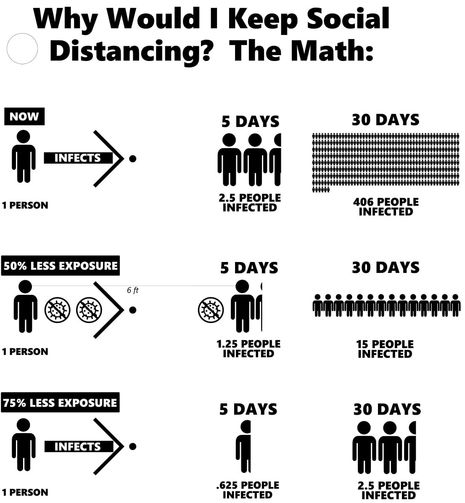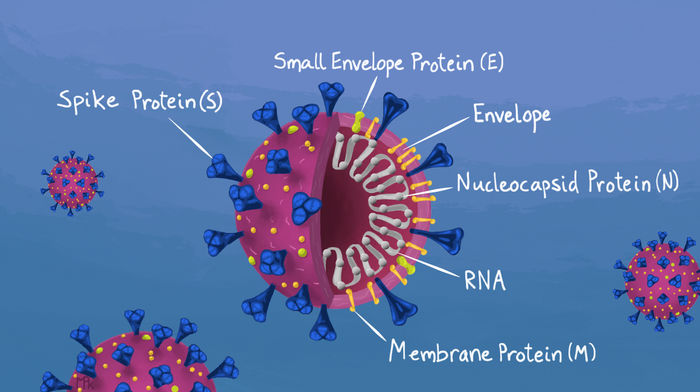The maths of COVID-19
What is an R number, and what exactly is herd immunity? Nick Scott explains what these various concepts mean, and answers whether someone hit by a car can be counted as a Covid-19 death

COVID-19 has dominated the media for the past year, and a lot of terminology that was once used only by specialists is now part of our vocabulary. But there is still much confusion about what exactly some of the terms used to describe the mathematics of COVID-19 mean, and about how exactly statistics related to COVID-19 are calculated. In this article, I hope to provide some simple explanations of these issues.
What is the R number?
The R0 number (“R nought”) of an infectious disease, called the basic reproductive number, is defined to be the theoretical average number of people infected by one person with the disease, in the absence of mitigating factors like vaccinations. This varies from disease to disease, and depends on many factors (e.g. it could be different in different countries): the R0 number for measles, for example, has been estimated as being anything between 12 and 18.
The R number, the effective reproductive number, is given by the average number of infections one infected person is causing in practice. The aim of measures such as lockdowns, mask requirements and social distancing is to reduce the R number. The goal is to get the R number below 1; if each infected person infects fewer than one other person, then the total number of active cases of the disease will drop. If instead the R number is above 1, cases will rise exponentially (i.e. the number of cases will increase by a constant multiplicative factor each week).
The UK government publishes estimates for the R number across the country.
What is herd immunity?
The most basic mathematical models of infectious diseases assume that everyone in the population can be infected. In reality, people can be immune, through previous infection, vaccination, or potentially in other ways such as cross-immunity from other viruses in the coronavirus family. This has the effect of reducing the R number: if 50% of the population has immunity to COVID-19, then someone who would have passed the disease on to 10 people will only pass it on to 5 (on average). Any level of immunity reduces the R number, which makes “achieving herd immunity” a slightly misleading phrase (it is not as though going from 79% of people immune, say, to 80%, has any particularly large effect). The term “herd immunity” is typically used to refer to the level of immunity in the population needed to lower the R number below 1 in the absence of other restrictions. This is where the idea of ending the pandemic by allowing most of the population to be infected comes from.
Scientists disagree on the level of immunity required for herd immunity to be reached with COVID-19. The other factor to note is that herd immunity through infection assumes that COVID-19 infection causes complete immunity forever. This is not true – reinfection is possible, though rare, and is seen as a particularly worrisome risk with the South African and Brazilian COVID-19 variants.
Has anywhere in the world achieved herd immunity?

There are a number of places across the world that have been described as having or being close to herd immunity, often by somewhat questionable sources, and have subsequently faced another COVID-19 wave: London (Daily Express, 3 December 2020), the whole UK (9news, 11 August 2020), “parts of New York, London and Mumbai” (New York Times, 17 August 2020), Stockholm (CNBC, 22 April 2020), Manaus (The Conversation, 29 September 2020). That makes any such prediction rather risky.
If I had to guess as to a location that may be close to herd immunity, though, I would pick North and South Dakota. More than 12% of the population of each state has had a positive COVID-19 test, rising to 15% of people in Bismarck, the capital of North Dakota; almost 1 in 500 people there have died. This is probably a massive underestimate (South Dakota had a positivity rate of nearly 60% in November). Both states have had limited COVID-19 restrictions; neither ordered a lockdown in March, while Kristi Noem, the governor of South Dakota boasted in a Wall Street Journal article that she hadn’t issued a mask mandate or forced businesses to close. Yet cases in both have been dropping since November.
How are COVID-19 deaths measured?
There are two main measures of COVID-19 deaths used in the UK. One figure, used more commonly, counts the number of people who have died within 28 days of testing positive for COVID-19. The other figure measures the number of deaths where COVID-19 was mentioned on the death certificate, which includes people who were suspected to have had the disease and is therefore slightly higher.
“The point of the 28-day rule is not that it is a perfect measure, but that it is the best simple estimate available”
What is considered a COVID-19 death in Britain was changed in August 2020, from any death after a positive test to only deaths within 28 days of testing positive. The total number of deaths was reduced by more than 5,000 when this change was made; people who had died months after testing positive, and could have died for unrelated reasons, were removed from the count.
Is it true that someone hit by a car is counted as a COVID-19 death?
This is literally true, but often said in a misleading way to imply that this accounts for a significant proportion of reported COVID-19 deaths. In fact, there were 1,752 road deaths in Great Britain in 2019 – less than 2% of the number of COVID-19 deaths, and therefore the number of people to have died in that way (or indeed in any sort of accident) within 28 days of testing positive is probably 100 or less.
The point of the 28-day rule is not that it is a perfect measure, but that it is the best simple estimate available. Whatever number of days after a positive test we choose, we will exclude some deaths caused by COVID-19 (for example, one man spent four months in a coma because of the disease – though he survived) and include some deaths with unrelated causes. The number 28 was chosen (based on evidence) to try to balance these two effects in order to give an estimate that is as accurate as possible.
 News / Eight Cambridge researchers awarded €17m in ERC research grants27 December 2025
News / Eight Cambridge researchers awarded €17m in ERC research grants27 December 2025 News / Clare Hall spent over £500k opposing busway 24 December 2025
News / Clare Hall spent over £500k opposing busway 24 December 2025 Comment / League tables do more harm than good26 December 2025
Comment / League tables do more harm than good26 December 2025 Comment / The ‘class’ of Cambridge24 December 2025
Comment / The ‘class’ of Cambridge24 December 2025 News / Caius mourns its tree-mendous loss23 December 2025
News / Caius mourns its tree-mendous loss23 December 2025









